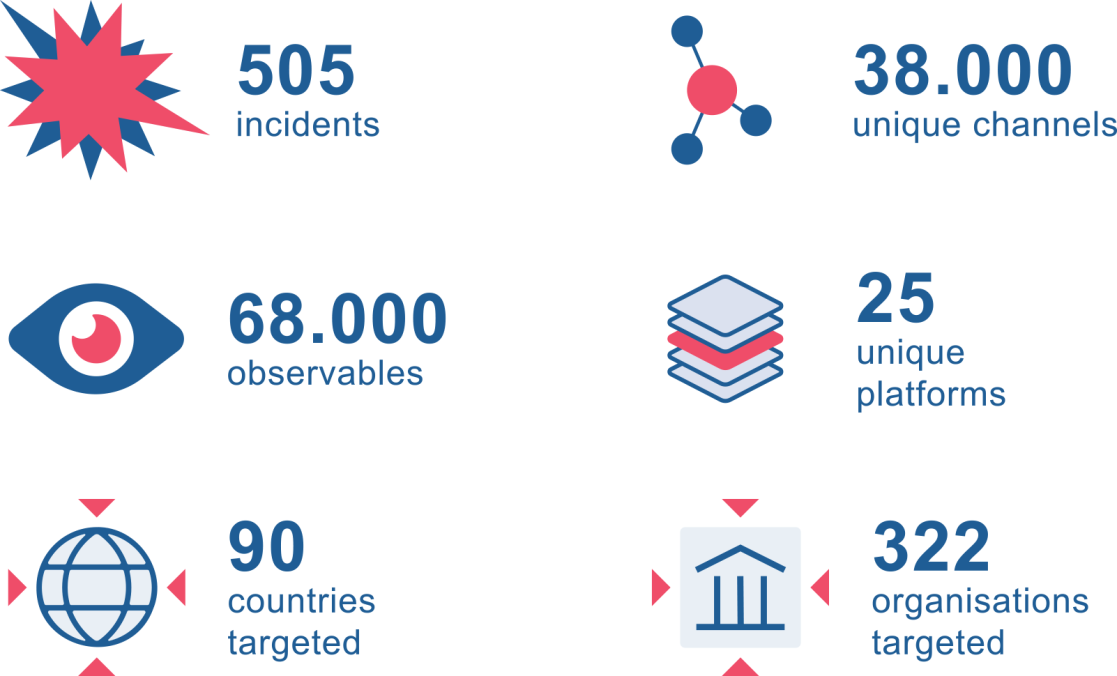Inside the infrastructure of Foreign Information Manipulation and Interference (FIMI) operations

Watch the keynote speech by High Representative for Foreign Affairs and Security Policy Kaja Kallas
One of the ways in which the EU tackles this persistent threat to democracy is by detecting the increasingly sophisticated incidents of Foreign Information Manipulation and Interference (FIMI). The data from this monitoring of FIMI activity allows EU Member States, international partners and the FIMI Defender community to fine-tune their responses to these incidents as well as to better understand and prevent these threats to their democracies.
Mapping the complex connections and channels used to manipulate information

European Union, 2025
Download the above image in high resolution (PDF file, opens in new window)
Each year, the EU External Action Service produces a report providing a comprehensive picture of FIMI activities taking place across different information environments, as well as looking at the tools, processes and initiatives that used to counter these incidents.
These reports also set out how, taken together, these insights on FIMI can feed into collective response frameworks for use by countries, civil society and individuals to help everyone become more resilient to these attacks.
The latest EEAS report on Foreign Information Manipulation and Interference (FIMI) threats maps out the digital infrastructure deployed by foreign actors, mainly by Russia, but also by China, to manipulate and interfere in the information space of the EU and partner countries with the objective to spread disinformation, to erode trust and undermine democratic societies. This map shows how attributed channels are only the tip of the iceberg of FIMI activities as they rely with extensive covert networks of channels with hidden connections, such as Doppelganger, African Initiative, Portal Kombat or False Façade.
Investigations by the EEAS reveal that:
- Over 500 FIMI incidents took place across 2024
- Threat actors used at least 25 different platforms and at least 38, 000 different accounts were involved in FIMI activities
- 322 organisations have been targeted by FIMI operations
- FIMI incidents in 2024 were spread across 90 different countries

European Union, 2025
The latest EEAS Threat Report, the 3rd in a series, also presents a model for revealing the connections between digital channels used in FIMI activities and the underlying infrastructure of threat actors, known as the FIMI Exposure Matrix. This model is key for exposing FIMI operations, establishing precise terminology for the activities carried out by threat actors and enabling the implementation of effective, evidence-based responses.
The report also presents key figures from the year including a special focus on information manipulation activities carried out by Russia and China. Case studies on Moldova and Africa illustrate how Russia tailors its strategies to geopolitical and local political shifts.

European Union, 2025
Through network analysis, the EEAS report on FIMI Threats maps the interactions between different types of networks across multiple platforms, as well as analysing how FIMI operations are adapting to emerging digital environments.
EEAS annual conference on Countering Foreign Information Manipulation and Interference
These findings and recommendations are the major topic of discussion at the annual EEAS conference on Countering Foreign Information Manipulation and Interference, on 18 March 2025. The event includes talks from expert speakers from across the EU institutions as well as from EU Member States, Ukraine and Moldova.
The conference will also exchange best practices when it comes to preserving information integrity in different regions including EU candidate countries, Australia and Sub-Saharan Africa. The role of Foreign Information Manipulation and Interference (FIMI) within the broader hybrid conflict landscape is also on the agenda.
Background: how the EEAS monitors and reports on FIMI threats
Through its annual FIMI Threat Reports, the EEAS reaffirms its long-term commitment to effectively combating FIMI, delivering impactful results, refining innovative solutions for the FIMI defenders community, and setting a benchmark for collaborative action against this global threat.
Each FIMI threat report builds on the insights and tools introduced in previous editions, in doing so enhancing the EU’s capacity to address the evolving landscape of FIMI threats. Each report focuses on different aspects of the fight against FIMI:
- Analysis of FIMI activities: the 1st FIMI Report set out the FIMI Methodology, a ground-breaking analytical framework that aimed to standardise an approach for investigating FIMI activities.
- Countering FIMI threats: the 2nd FIMI Report focus on the activation of collective mechanisms to counter and respond to FIMI, detailing strategies for coordinated multi-stakeholder responses among the EU and its partners, particularly against FIMI campaigns targeting democratic processes like elections.
The overarching aim of each of these reports into Foreign Information Manipulation and Interference is to enhance understanding of FIMI operations in a way that improves EU Member States’ responses, expands the FIMI defenders community and strengthens democratic resilience.




